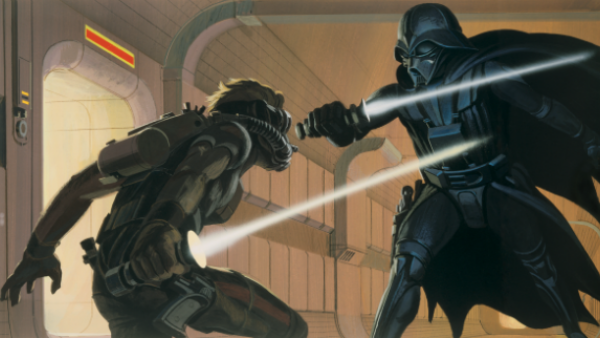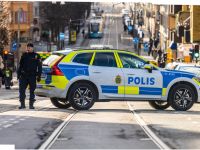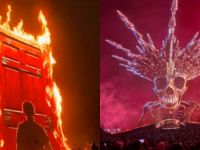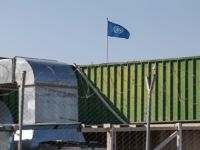The Complete "Story of Star Wars":
Part 1: "Out of the Past"
Part 2: "Annikin Starkiller"
Part 3: "A Cohesive Reality"
Part 4: "A Desert Planet"
Part 5: "What a Load of Rubbish"
Part 6: "Darth Farmer"
Part 7: "Binary Sunset"
***
Fridays were for BBQs. Lucas took the opportunity to show his friends his script, tape-recording their reactions for his revisions.
Among these was Marcia Lucas (née Griffin), George’s wife. An assistant film editor who’d built a reputation with her understanding of story and character, Marcia was an especially ardent critic of Lucas’s writing, pointing-out what worked, what didn’t, making suggestions and constantly reminding her husband that a good story needed an emotional through-line. He had learned to trust her, and listened to her feedback carefully.

Above: Marcia and George Lucas. (Source unknown)
He spent his time watching and reading science fiction, working new influences into the story as, slowly, the script was refined.
Kane disappeared. Han became a bearded, flamboyant pirate, human because Lucas thought that would allow potentially deeper relationships with other human characters. Chewbacca became an 8 foot tall alien armed with a crossbow-shaped rifle.
Most importantly, Luke—after George Lucas’s nickname, but now Luke Starkiller—was transformed into a young idealist. He had several brothers and a father who appeared at the end of the film. He gained a more prominent role, taking centre stage from the General and Princess and relegating them into secondary characters.
The temptation concept was introduced: the idea that a Jedi could fall to “the dark side.” A father-son dynamic was tweaked; there was now the possibility of a man’s son training under that father’s friend.
The Hidden Fortress’s inspiration made a comeback here: the two robots (or droids) that opened earlier drafts made a return. C-3PO and R2-D2 kick-start the action by making a daring escape from one of the Galactic Empire’s ships.
A third draft refined things further: Luke became a single, orphaned child, with one Ben Kenobi as his father figure. Han became a lovable rogue—“a tough James Dean style starpilot.”
Non sci-fi inspirations abounded, including another Kurosawa film, 1961’s Yojimbo (itself inspired by Dashiell Hammett novels), which notably inspired a confrontation between Han Solo and an alien named Greedo; Kurosawa’s 1975 film Dersu Uzala, which inspired a scene where Luke stares-out onto the “binary sunset” of Tatooine; and the 1955 film The Dam Busters, a World War II drama about Royal Air Force bombers attacking the Nazis and from which Lucas “lifted” several lines of dialogue for his film’s ending sequence. It also inspired the stakes and shape of that climax: in The Dam Busters, pilots have to manoeuvre aircraft through a trench, evading enemy fire to launch a special weapon from a precise distance at a target in order to destroy an enemy base. If one pilot fails, another pilot attempts the same. This was lifted wholesale for Lucas’s script.

Above: A poster for The Dam Busters. (StudioCanal)
Ideas came and went. Realizing that his film lacked many women—and perhaps responding to the criticism that American Graffiti had neglected to discuss the fates of its female characters in its ending, focusing only on the men—Luke was temporarily female. Lucas changed his mind, crumpling Annikin’s brother into the bin and redrafting the Princess with his role in mind, giving her a more prominent character. Luke’s father general disappeared, becoming a casualty of a war. At one point, Lucas considered giving the script a narrative framing device: it would be a bedtime story told by an alien mother—species name: Wookie—to her son.
Budgetary considerations also came to the forefront. The number of special effects went down; the opening scene, for example, once depicting a small spaceship on the loose from four colossal battleships, was rewritten to be a 1-on-1 affair. Scenes were re-shifted to make better use of settings, with others thrown out completely.
 \
\

Above: An annotated version of a script, dated 1976. (Lucasfilm)
He wrote and wrote and wrote, and the story eventually got away from him. During script development, he realised the film he would be making would cover about a third of the material he had in mind. For the rest of the story to be told the way he wanted, he thought, he would have to ensure he’d be the one behind it.
A fourth draft—in collaboration with married couple Willard Huyck and Gloria Katz—brought the script that much closer to a workable film script.
The script came with concept art by Ralph McQuarrie—the beginning of the film’s, and the key to getting Twentieth Century Fox to see what Lucas was envisioning.
Starting in January 1975, McQuarrie painted the characters and landscapes of the film, finally giving Lucas’s imagination form. His work was especially important in creating the two droids who opened the film, the affable C-3PO and R2-D2. C-3PO, a humanoid, gold-coloured droid perpetually stuck in a state of anxiety, was inspired by the Maschinenmensch of Fritz Lang’s 1927 film Metropolis. R2-D2, on the other hand, were inspired by Silent Running (1972)’s short, square-shaped robots Huey, Louie, and Duey. Drawing inspiration from his tripod, McQuarrie gave R2-D2 three legs.
Lucas had imagined the film’s antagonist as a human with his face clothed, like a Saracen warrior, but had also provided McQuarrie with a book on medieval Japan from which to draw inspiration, as well as pulp illustrations depicting villains with capes. The influence of the samurai on Darth Vader’s outfit is obvious, but McQuarrie considered the practical aspects of space travel. Wouldn’t Vader be wearing something to breathe? he thought. He fitted his face with a black gas mask and furnished the cape. The effect was immediate and stunning. McQuarrie topped things off by painting the Death Star and an important cantina scene—one in which he also painted the first Stormtrooper.



Above: McQuarrie's sketch of R2-D2 and C-3PO; the Darth Vader painting; his later painting of a Stormtrooper. (Lucasfilm)
Further concept art was furnished by Colin Cantwell, a veteran of Stanley Kubrick’s 2001: A Space Odyssey. Cantwell had provided sketches for the film’s vehicles and spaceships based off Lucas’s descriptions: X-Wings and Stardestroyers, Landspeeders and the Millennium Falcon. Colin hadn’t bothered too much with realism; his goal was to design vehicles which both looked cool and were easily differentiable, allowing audience members to quickly tell if a spaceship belonged to the protagonists or antagonists.
The presentation impressed the studio enough that they put-up $8.25 million. And, because American Graffiti had been a smash hit—the third best-grossing film of that year—it gave Lucas the leverage he needed to acquire sequel rights from the deal. Lucas was hoping he’d make t-shirts and posters to sell a movie and sequels he was confident the studio wouldn’t back-up after box office disappointment. “I knew,” he would later say, “that it was going to be a disaster.”
The script was ready, and the studio had given him the green-light on preproduction. The film finally had a title, too:
The Star Wars: From the Adventures of Luke Starkiller
***
Lucas had founded Industrial Light and Magic in 1975, after learning that Twentieth Century Fox, like other studios in a market keen on realism, had shut down its expensive effects department.
Leading the ILM team was John Dykstra, who’d cut his teeth filming model effects on Silent Running soon after university. ILM consisted of a rag-tag army of architects, engineers, and commercials effects supervisors, with very little feature film experience among them. The pay wasn’t that great, either—something like $20,000 a year on average. But they had spirit.
The team began work in a huge, abandoned warehouse in Van Nuys, California, one so empty that it in the beginning they used it for parking space. They were tasked with developing motion control photography for the movie, creating cameras that used optical illusions to project size on small models.

Above: ILM in the late 1970s. (Source unknown)
“[Motion control photography] is essentially an old concept of being able to duplicate camera motion through more than one pass so that you could generate multiple elements of film,” Dykstra said in 2004. “We made it production-savvy by tying it into a computer, which was, at that point, custom-built microprocessors…we built ‘em from scratch.”
Lucas would come in and occasionally provide feedback. He envisioned a “used future” backdrop—one where it was apparent that people actually lived, where high-tech machinery had accumulated the grime of everyday use. The film had “no points of reference to Earth time or space, with which we are familiar,” Lucas said, “and it [was] not about the future…[but] a decidedly inhabited and used place where the hardware is taken for granted.” In a nutshell, he would tell his production designers, he wanted it all to be “real.”
This “used future” look was partially a practical necessity. Technically, design on The Star Wars: From the Adventures of Luke Starkiller began before the film’s approval. But the American Graffiti money Lucas had put forward to get things going dried-up. This forced the production team to use unconventional methods to reach their desired look—including liberal use of scrap to make things look old. Designers used scrap airplane metal to build sets, which totalled 30 in number; all nine stages of Elstree Studios (in Hertfordshire), plus a massive sound stage at Shepperton Studios, were used to hold them.
This “realness” would also seep into how Lucas wanted to film. The setting was outlandish and the story had the feel of a fairytale; Lucas decided it would need a “cohesive reality,” created through the style with which it was filmed. Gilbert Taylor was brought in.
Taylor was an experienced filmmaker, one who’d proven his mettle by working with Stanley Kubrick on Dr. Strangelove (1964), with the Beatles on A Hard Day’s Night (1964), and the special effects sequences in The Dam Busters. Lucas liked his “eccentric” style—and, more importantly, the documentary feel he brought to his work.
NEXT: "A Desert Planet"







